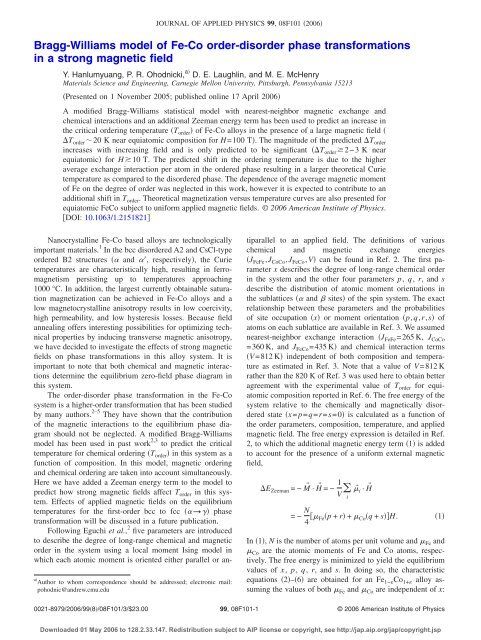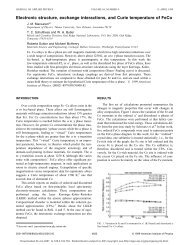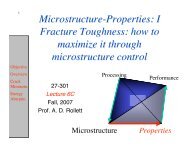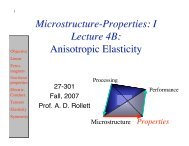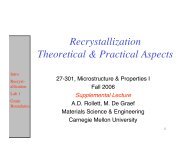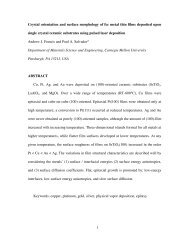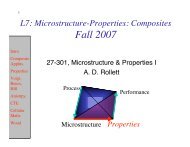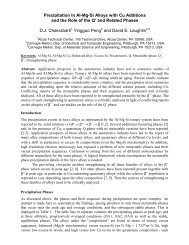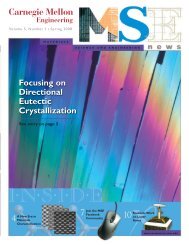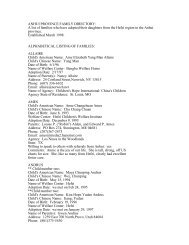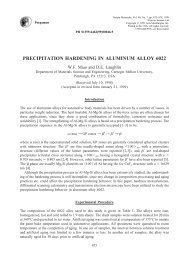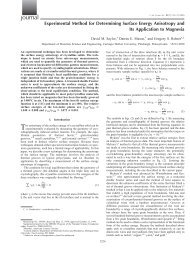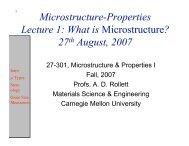Bragg-Williams model of Fe-Co order-disorder phase - ResearchGate
Bragg-Williams model of Fe-Co order-disorder phase - ResearchGate
Bragg-Williams model of Fe-Co order-disorder phase - ResearchGate
Create successful ePaper yourself
Turn your PDF publications into a flip-book with our unique Google optimized e-Paper software.
<strong>Bragg</strong>-<strong>Williams</strong> <strong>model</strong> <strong>of</strong> <strong>Fe</strong>-<strong>Co</strong> <strong>order</strong>-dis<strong>order</strong> <strong>phase</strong> transformations<br />
in a strong magnetic field<br />
Y. Hanlumyuang, P. R. Ohodnicki, a D. E. Laughlin, and M. E. McHenry<br />
Materials Science and Engineering, Carnegie Mellon University, Pittsburgh, Pennsylvania 15213<br />
Presented on 1 November 2005; published online 17 April 2006<br />
A modified <strong>Bragg</strong>-<strong>Williams</strong> statistical <strong>model</strong> with nearest-neighbor magnetic exchange and<br />
chemical interactions and an additional Zeeman energy term has been used to predict an increase in<br />
the critical <strong>order</strong>ing temperature T<strong>order</strong> <strong>of</strong> <strong>Fe</strong>-<strong>Co</strong> alloys in the presence <strong>of</strong> a large magnetic field <br />
T<strong>order</strong>20 K near equiatomic composition for H=100 T. The magnitude <strong>of</strong> the predicted T<strong>order</strong> increases with increasing field and is only predicted to be significant T<strong>order</strong>2−3 K near<br />
equiatomic for H10 T. The predicted shift in the <strong>order</strong>ing temperature is due to the higher<br />
average exchange interaction per atom in the <strong>order</strong>ed <strong>phase</strong> resulting in a larger theoretical Curie<br />
temperature as compared to the dis<strong>order</strong>ed <strong>phase</strong>. The dependence <strong>of</strong> the average magnetic moment<br />
<strong>of</strong> <strong>Fe</strong> on the degree <strong>of</strong> <strong>order</strong> was neglected in this work, however it is expected to contribute to an<br />
additional shift in T<strong>order</strong>. Theoretical magnetization versus temperature curves are also presented for<br />
equiatomic <strong>Fe</strong><strong>Co</strong> subject to uniform applied magnetic fields. © 2006 American Institute <strong>of</strong> Physics.<br />
DOI: 10.1063/1.2151821<br />
Nanocrystalline <strong>Fe</strong>-<strong>Co</strong> based alloys are technologically<br />
important materials. 1 In the bcc dis<strong>order</strong>ed A2 and CsCl-type<br />
<strong>order</strong>ed B2 structures and , respectively, the Curie<br />
temperatures are characteristically high, resulting in ferromagnetism<br />
persisting up to temperatures approaching<br />
1000 °C. In addition, the largest currently obtainable saturation<br />
magnetization can be achieved in <strong>Fe</strong>-<strong>Co</strong> alloys and a<br />
low magnetocrystalline anisotropy results in low coercivity,<br />
high permeability, and low hysteresis losses. Because field<br />
annealing <strong>of</strong>fers interesting possibilities for optimizing technical<br />
properties by inducing transverse magnetic anisotropy,<br />
we have decided to investigate the effects <strong>of</strong> strong magnetic<br />
fields on <strong>phase</strong> transformations in this alloy system. It is<br />
important to note that both chemical and magnetic interactions<br />
determine the equilibrium zero-field <strong>phase</strong> diagram in<br />
this system.<br />
The <strong>order</strong>-dis<strong>order</strong> <strong>phase</strong> transformation in the <strong>Fe</strong>-<strong>Co</strong><br />
system is a higher-<strong>order</strong> transformation that has been studied<br />
by many authors. 2–5 They have shown that the contribution<br />
<strong>of</strong> the magnetic interactions to the equilibrium <strong>phase</strong> diagram<br />
should not be neglected. A modified <strong>Bragg</strong>-<strong>Williams</strong><br />
<strong>model</strong> has been used in past work 2,3 to predict the critical<br />
temperature for chemical <strong>order</strong>ing T <strong>order</strong> in this system as a<br />
function <strong>of</strong> composition. In this <strong>model</strong>, magnetic <strong>order</strong>ing<br />
and chemical <strong>order</strong>ing are taken into account simultaneously.<br />
Here we have added a Zeeman energy term to the <strong>model</strong> to<br />
predict how strong magnetic fields affect T <strong>order</strong> in this system.<br />
Effects <strong>of</strong> applied magnetic fields on the equilibrium<br />
temperatures for the first-<strong>order</strong> bcc to fcc \ <strong>phase</strong><br />
transformation will be discussed in a future publication.<br />
Following Eguchi et al., 2 five parameters are introduced<br />
to describe the degree <strong>of</strong> long-range chemical and magnetic<br />
<strong>order</strong> in the system using a local moment Ising <strong>model</strong> in<br />
which each atomic moment is oriented either parallel or an-<br />
a<br />
Author to whom correspondence should be addressed; electronic mail:<br />
pohodnic@andrew.cmu.edu<br />
JOURNAL OF APPLIED PHYSICS 99, 08F101 2006<br />
tiparallel to an applied field. The definitions <strong>of</strong> various<br />
chemical and magnetic exchange energies<br />
J <strong>Fe</strong><strong>Fe</strong>,J <strong>Co</strong><strong>Co</strong>,J <strong>Fe</strong><strong>Co</strong>,V can be found in Ref. 2. The first parameter<br />
x describes the degree <strong>of</strong> long-range chemical <strong>order</strong><br />
in the system and the other four parameters p, q, r, and s<br />
describe the distribution <strong>of</strong> atomic moment orientations in<br />
the sublattices and sites <strong>of</strong> the spin system. The exact<br />
relationship between these parameters and the probabilities<br />
<strong>of</strong> site occupation x or moment orientation p,q,r,s <strong>of</strong><br />
atoms on each sublattice are available in Ref. 3. We assumed<br />
nearest-neighbor exchange interaction J <strong>Fe</strong><strong>Fe</strong>=265 K, J <strong>Co</strong><strong>Co</strong><br />
=360 K, and J <strong>Fe</strong><strong>Co</strong>=435 K and chemical interaction terms<br />
V=812 K independent <strong>of</strong> both composition and temperature<br />
as estimated in Ref. 3. Note that a value <strong>of</strong> V=812 K<br />
rather than the 820 K <strong>of</strong> Ref. 3 was used here to obtain better<br />
agreement with the experimental value <strong>of</strong> T <strong>order</strong> for equiatomic<br />
composition reported in Ref. 6. The free energy <strong>of</strong> the<br />
system relative to the chemically and magnetically dis<strong>order</strong>ed<br />
state x= p=q=r=s=0 is calculated as a function <strong>of</strong><br />
the <strong>order</strong> parameters, composition, temperature, and applied<br />
magnetic field. The free energy expression is detailed in Ref.<br />
2, to which the additional magnetic energy term 1 is added<br />
to account for the presence <strong>of</strong> a uniform external magnetic<br />
field,<br />
E Zeeman =−M · H =− 1<br />
V i<br />
i · H <br />
=− N<br />
4 <strong>Fe</strong>p + r + <strong>Co</strong>q + sH. 1<br />
In 1, N is the number <strong>of</strong> atoms per unit volume and <strong>Fe</strong> and<br />
<strong>Co</strong> are the atomic moments <strong>of</strong> <strong>Fe</strong> and <strong>Co</strong> atoms, respectively.<br />
The free energy is minimized to yield the equilibrium<br />
values <strong>of</strong> x, p, q, r, and s. In doing so, the characteristic<br />
equations 2–6 are obtained for an <strong>Fe</strong> 1−<strong>Co</strong> 1+ alloy assuming<br />
the values <strong>of</strong> both <strong>Fe</strong> and <strong>Co</strong> are independent <strong>of</strong> x:<br />
0021-8979/2006/998/08F101/3/$23.00 99, 08F101-1<br />
© 2006 American Institute <strong>of</strong> Physics<br />
Downloaded 01 May 2006 to 128.2.33.147. Redistribution subject to AIP license or copyright, see http://jap.aip.org/jap/copyright.jsp
08F101-2 Hanlumyuang et al. J. Appl. Phys. 99, 08F101 2006<br />
x = kT + x + p1− + x − p1+ + x + q1+ + x − q<br />
ln1− , 2<br />
8V 1− − x + r1− − x − r1+ − x + s1+ − x − s<br />
H<br />
2 <strong>Fe</strong> + J<strong>Fe</strong><strong>Fe</strong>r + J<strong>Fe</strong><strong>Co</strong>q = kT + x + p<br />
ln1− , 3<br />
4 1− + x − p<br />
H<br />
2 <strong>Co</strong> + J<strong>Co</strong><strong>Co</strong>s + J<strong>Fe</strong><strong>Co</strong>p = kT + x + q<br />
ln1+ , 4<br />
4 1+ + x − q<br />
H<br />
2 <strong>Fe</strong> + J<strong>Fe</strong><strong>Fe</strong>p + J<strong>Fe</strong><strong>Co</strong>s = kT − x + r<br />
ln1− , 5<br />
4 1− − x − r<br />
H<br />
2 <strong>Co</strong> + J<strong>Co</strong><strong>Co</strong>q + J<strong>Fe</strong><strong>Co</strong>r = kT − x + s<br />
ln1+ . 6<br />
4 1+ − x − s<br />
In Eqs. 2–6, k is the Boltzmann constant and<br />
J<strong>Fe</strong><strong>Fe</strong>a, J<strong>Co</strong><strong>Co</strong>, J<strong>Fe</strong><strong>Co</strong>, and V are expressed in units <strong>of</strong> energy.<br />
Although the moment <strong>of</strong> <strong>Co</strong> atoms does not depend significantly<br />
on the identity <strong>of</strong> nearest neighbors, the atomic moment<br />
<strong>of</strong> <strong>Fe</strong> in <strong>Fe</strong>-<strong>Co</strong> alloys is known to be dependent on the<br />
number <strong>of</strong> <strong>Co</strong> nearest neighbors. 7,8 <strong>Co</strong>nsequently, the average<br />
value <strong>of</strong> <strong>Fe</strong> depends on both composition and degree <strong>of</strong><br />
<strong>order</strong> while <strong>Co</strong> is relatively constant with a value <strong>of</strong><br />
1.8B. For the purpose <strong>of</strong> brevity, the variation <strong>of</strong> <strong>Fe</strong> with<br />
the degree <strong>of</strong> <strong>order</strong> is neglected in the present work unless<br />
otherwise specified and the average <strong>Fe</strong> moment for fully dis<strong>order</strong>ed<br />
<strong>Fe</strong><strong>Co</strong> Ref. 8 is used for <strong>Fe</strong>. The additional complication<br />
has been accounted for through generalization <strong>of</strong><br />
2 in calculations not presented here. The estimated effect<br />
on the external field dependence <strong>of</strong> T<strong>order</strong> was found to be<br />
secondary for most compositions. Nevertheless, these modifications<br />
to the <strong>model</strong> will be discussed in a future publication.<br />
The <strong>order</strong> parameters were numerically calculated as<br />
functions <strong>of</strong> temperature by solving the characteristic equations<br />
2–6. Figure 1 illustrates the plot <strong>of</strong> x, p, q, r, and s<br />
for the equiatomic composition in the case <strong>of</strong> both H=0<br />
dashed and H=100 T solid. At zero field, the relevant<br />
<strong>order</strong>ing temperatures T<strong>order</strong> and TCurie predicted by the<br />
<strong>model</strong> for equiatomic composition agree with the original<br />
calculations by Eguchi in Ref. 3. The effect <strong>of</strong> the applied<br />
field is to stabilize some degree <strong>of</strong> magnetic <strong>order</strong><br />
p,q,r,s0 at temperatures above the theoretical Curie<br />
temperature. It can also be observed that at the equiatomic<br />
composition T<strong>order</strong> increases by 20 K in the presence <strong>of</strong> the<br />
100 T field, indicating that the <strong>order</strong>ed <strong>phase</strong> is stabilized<br />
relative to the dis<strong>order</strong>ed <strong>phase</strong>. The inset <strong>of</strong> Fig. 1 illustrates<br />
the shift <strong>of</strong> T<strong>order</strong> as a function <strong>of</strong> applied field for the equiatomic<br />
composition. Notice that while deviations from linearity<br />
are observed for relatively small applied fields H<br />
10−20 T, the shift in the <strong>order</strong>ing temperature scales approximately<br />
linearly with increasing field in the high-field<br />
regime.<br />
It should be reiterated that the TCurie indicated in Fig. 1 is<br />
the theoretical value predicted by the <strong>model</strong> for thermal equi-<br />
librium. Because T <strong>order</strong>T Curie in this system, the equilibrium<br />
value <strong>of</strong> T Curie corresponds to that <strong>of</strong> the dis<strong>order</strong>ed<br />
<strong>phase</strong>. In reality, the T Curie <strong>of</strong> Fig. 1 cannot observed experimentally<br />
for equiatomic composition as the bcc ferromagnetic<br />
to fcc paramagnetic <strong>phase</strong> transformation results in a<br />
loss <strong>of</strong> ferromagnetism and occurs at a temperature below<br />
T Curie <strong>of</strong> the dis<strong>order</strong>ed <strong>phase</strong>. All theoretical Curie temperatures<br />
stated in this work correspond to the T Curie that<br />
would be observed if the <strong>phase</strong> under consideration remained<br />
stable up to the temperature <strong>of</strong> interest.<br />
Because the estimated value <strong>of</strong> J <strong>Fe</strong><strong>Co</strong> is greater than both<br />
J <strong>Fe</strong><strong>Fe</strong> and J <strong>Fe</strong><strong>Co</strong> in this <strong>model</strong>, the effective exchange interaction<br />
in the chemically <strong>order</strong>ed state is larger than that <strong>of</strong> the<br />
dis<strong>order</strong>ed state J eff=J <strong>Fe</strong><strong>Co</strong> for x=1 as compared to J eff<br />
= 1<br />
4J<strong>Fe</strong><strong>Fe</strong>+ 1<br />
4J<strong>Co</strong><strong>Co</strong>+ 1<br />
2J<strong>Fe</strong><strong>Co</strong> for x=0 at equiatomic composition.<br />
The theoretical Curie temperature <strong>of</strong> the fully <strong>order</strong>ed<br />
<strong>phase</strong> is therefore predicted to be larger than the theoretical<br />
Curie temperature <strong>of</strong> the fully dis<strong>order</strong>ed <strong>phase</strong> 1720 and<br />
1500 K, respectively resulting in a greater degree <strong>of</strong> magnetic<br />
<strong>order</strong> at finite temperatures below the Curie temperature<br />
<strong>of</strong> the maximally <strong>order</strong>ed alloy in zero field. A larger<br />
magnetization is therefore predicted for the <strong>order</strong>ed <strong>phase</strong> in<br />
the vicinity <strong>of</strong> the zero-field critical <strong>order</strong>ing temperature,<br />
and the reduction in free energy <strong>of</strong> the maximally <strong>order</strong>ed<br />
<strong>phase</strong> due to an applied magnetic field is larger than that <strong>of</strong><br />
the dis<strong>order</strong>ed <strong>phase</strong>. As a result, the <strong>order</strong>ed state is stabilized<br />
relative to the dis<strong>order</strong>ed state and a shift in T<strong>order</strong> to<br />
higher temperatures is observed. In support <strong>of</strong> the previous<br />
statements, the difference between the Curie temperature <strong>of</strong><br />
the <strong>order</strong>ed and dis<strong>order</strong>ed <strong>phase</strong>s disappears entirely for a<br />
hypothetical case in which the <strong>order</strong>ed and dis<strong>order</strong>ed states<br />
are assigned the same effective exchange interaction per<br />
atom J<strong>Fe</strong><strong>Fe</strong>=J <strong>Co</strong><strong>Co</strong>=J <strong>Fe</strong><strong>Co</strong>. In addition, a shift in T<strong>order</strong> cannot<br />
be induced through the application <strong>of</strong> a field.<br />
The critical <strong>order</strong>ing temperatures were calculated for a<br />
range <strong>of</strong> compositions in <strong>order</strong> to observe how the <strong>order</strong>dis<strong>order</strong><br />
<strong>phase</strong> boundary changes as a function <strong>of</strong> applied<br />
field. Figure 2 illustrates the calculated <strong>phase</strong> boundary for<br />
H=0, 50, and 100 T as well as experimentally measured<br />
critical temperatures in the absence <strong>of</strong> a field. 6 Except for the<br />
fact that the peak in the experimental <strong>phase</strong> boundary does<br />
not occur at equiatomic composition, the <strong>model</strong> reproduces<br />
the variation in the <strong>order</strong>ing temperature reasonably well<br />
with composition at zero field, as first shown in Ref. 3. It is<br />
observed that the shift in the <strong>phase</strong> boundary due to an applied<br />
field is fairly symmetric and a maximum at the equiatomic<br />
composition.<br />
The <strong>model</strong> presented here has also been used to predict<br />
the magnetization behavior <strong>of</strong> the system in the presence <strong>of</strong><br />
strong magnetic fields as a function <strong>of</strong> temperature. The<br />
magnetization as a function <strong>of</strong> temperature can be calculated<br />
Downloaded 01 May 2006 to 128.2.33.147. Redistribution subject to AIP license or copyright, see http://jap.aip.org/jap/copyright.jsp
08F101-3 Hanlumyuang et al. J. Appl. Phys. 99, 08F101 2006<br />
FIG. 1. <strong>Co</strong>lor online Order parameters x, p, q, r, ands as a function <strong>of</strong><br />
temperature for both H=0 dotted lines and H=100 T solid lines. The<br />
inset illustrates the shift in the <strong>order</strong>ing temperature as a function <strong>of</strong> H.<br />
from the equilibrium values <strong>of</strong> p, q, r, and s see Fig. 1 for<br />
equiatomic according to the following expression:<br />
M = N<br />
4 <strong>Fe</strong>p + r + <strong>Co</strong>q + s. 7<br />
Figure 3 shows the theoretical magnetization curves for an<br />
equiatomic alloy in thermal equilibrium with applied fields<br />
<strong>of</strong> H=0, 1, 10, 50, and 100 T. A kink in the magnetization<br />
curve is observed at the T<strong>order</strong> due to the larger magnetization<br />
<strong>of</strong> the chemically <strong>order</strong>ed <strong>phase</strong> x=1. The kink is observed<br />
to shift to higher temperatures with increasing applied field<br />
as T<strong>order</strong> increases. Although the variation <strong>of</strong> the average<br />
atomic moment <strong>of</strong> <strong>Fe</strong> with degree <strong>of</strong> <strong>order</strong> was neglected in<br />
the previous discussion, the magnetization curves <strong>of</strong> Fig. 3<br />
do account for both the higher theoretical Curie temperature<br />
and higher average <strong>Fe</strong> moment <strong>of</strong> the <strong>order</strong>ed <strong>phase</strong>.<br />
FIG. 2. <strong>Co</strong>lor online Theoretically predicted <strong>order</strong>-dis<strong>order</strong> <strong>phase</strong> boundary<br />
as a function <strong>of</strong> applied magnetic field and comparison with experimental<br />
data Ref. 6.<br />
FIG. 3. <strong>Co</strong>lor online Theoretically predicted magnetization curves <strong>of</strong> equiatomic<br />
<strong>Fe</strong><strong>Co</strong> as a function <strong>of</strong> temperature for several applied magnetic<br />
fields.<br />
A modified <strong>Bragg</strong>-<strong>Williams</strong> <strong>model</strong> was used to predict<br />
the critical <strong>order</strong>ing temperatures for the bcc to CsCl-type<br />
<strong>phase</strong> transformation in binary <strong>Fe</strong><strong>Co</strong> alloys taking into account<br />
nearest-neighbor chemical interactions, magnetic exchange<br />
interactions, and the Zeeman energy <strong>of</strong> the system in<br />
uniform external fields. A shift <strong>of</strong> the <strong>order</strong>-dis<strong>order</strong> equilibrium<br />
<strong>phase</strong> boundary was observed in strong applied fields<br />
resulting in stabilization <strong>of</strong> the <strong>order</strong>ed <strong>phase</strong> relative to the<br />
dis<strong>order</strong>ed <strong>phase</strong>. Because the dependence <strong>of</strong> <strong>Fe</strong> moment on<br />
degree <strong>of</strong> <strong>order</strong> was neglected, the shift calculated here is<br />
due entirely to the larger effective exchange interaction per<br />
atom resulting in a larger theoretical Curie temperature <strong>of</strong> the<br />
<strong>order</strong>ed <strong>phase</strong> relative to the dis<strong>order</strong>ed <strong>phase</strong>. Even though<br />
short-range-<strong>order</strong> effects and the variation <strong>of</strong> <strong>Fe</strong> as a function<br />
<strong>of</strong> the degree <strong>of</strong> <strong>order</strong> were neglected in this work, it is<br />
believed that the qualitative features <strong>of</strong> the predictions stabilization<br />
<strong>of</strong> chemical <strong>order</strong> in the presence <strong>of</strong> strong applied<br />
magnetic fields remain valid when these additional complications<br />
are taken into account.<br />
MEM and DEL gratefully acknowledge support from the<br />
NSF under <strong>Co</strong>ntract No. DMR-0406220 for financial support<br />
<strong>of</strong> this work. PRO is supported by an NDSEG Graduate Research<br />
<strong>Fe</strong>llowship.<br />
1<br />
M. E. McHenry, M. A. Willard, and D. E. Laughlin, Prog. Mater. Sci. 44,<br />
291 1999.<br />
2<br />
T. Eguchi, C. Kinoshita, S. Kiyoto, and K. Yasutake, Jpn. J. Appl. Phys. 8,<br />
401 1966.<br />
3<br />
T. Eguchi, H. Matsuda, and K. Oki, IEEE Trans. Magn. 4, 4761968.<br />
4<br />
F. J. Martinez-Herrera, F. Mejia-Lira, F. Aguilera-Granja, and J. L. Moran-<br />
Lopez, Phys. Rev. B 31, 1686 1984.<br />
5<br />
I. Ohnuma, H. Enoki, O. Ikeda, R. Kainuma, H. Ohtani, B. Sundman, and<br />
K. Ishida, Acta Mater. 50, 379 2002.<br />
6<br />
J. A. Oyedele and M. F. <strong>Co</strong>llins, Phys. Rev. B 16, 32081977.<br />
7<br />
J. M. Maclaren, T. C. Schulthess, W. H. Butler, R. B. Sutton, and M. E.<br />
McHenry, J. Appl. Phys. 85, 4833 1999.<br />
8<br />
J. S. Kouvel, in Magnetism and Metallurgy, edited by A. Berkowitz and E.<br />
Kneller Academic, New York, 1969, p. 547.<br />
Downloaded 01 May 2006 to 128.2.33.147. Redistribution subject to AIP license or copyright, see http://jap.aip.org/jap/copyright.jsp


